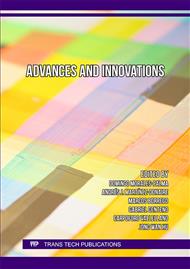[1]
P. Woizeschke, V. Wottschel, Recent Developments for Laser Beam Joining of CFRP-aluminum Structures, Procedia Materials Science. 2 (2013) 250–258.
DOI: 10.1016/j.mspro.2013.02.031
Google Scholar
[2]
F. Krebs, L. Larsen, G. Braun, W. Dudenhausen, Design of a multifunctional cell for aerospace CFRP production, Lecture Notes in Mechanical Engineering. 7 (2013) 515–524.
DOI: 10.1007/978-3-319-00557-7_42
Google Scholar
[3]
A. Çelik, I. Lazoglu, A. Kara, F. Kara, Wear on SiAlON ceramic tools in drilling of aerospace grade CFRP composites, Wear. 338–339 (2015) 11–21.
DOI: 10.1016/j.wear.2015.05.009
Google Scholar
[4]
A. Çelik, I. Lazoglu, A. Kara, F. Kara, Investigation on the performance of SiAlON ceramic drills on aerospace grade CFRP composites, J Mater Process Technol. 223 (2015) 39–47.
DOI: 10.1016/j.jmatprotec.2015.03.040
Google Scholar
[5]
R. Fu, Z. Jia, F. Wang, Y. Jin, D. Sun, L. Yang, D. Cheng, Drill-exit temperature characteristics in drilling of UD and MD CFRP composites based on infrared thermography, Int J Mach Tools Manuf. 135 (2018) 24–37.
DOI: 10.1016/j.ijmachtools.2018.08.002
Google Scholar
[6]
C.-Y. Wang, Y.-H. Chen, Q.-L. An, X.-J. Cai, W.-W. Ming, M. Chen, Drilling temperature and hole quality in drilling of CFRP/aluminum stacks using diamond coated drill, International Journal of Precision Engineering and Manufacturing. 16 (2015) 1689–1697.
DOI: 10.1007/s12541-015-0222-y
Google Scholar
[7]
J. Mu, J.H. Xu, Y. Chen, Y.C. Fu, Experimental Research on Temperature of Drilling CFRP with Brazed Diamond Core Drill, Materials Science Forum. 800–801 (2014) 776–781.
DOI: 10.4028/www.scientific.net/MSF.800-801.776
Google Scholar
[8]
S. Fernandez-Vidal, S. Fernandez-Vidal, M. Batista, J. Salguero, Tool Wear Mechanism in Cutting of Stack CFRP/UNS A97075, Materials. 11 (2018) 1276.
DOI: 10.3390/ma11081276
Google Scholar
[9]
A. D'Orazio, M. el Mehtedi, A. Forcellese, A. Nardinocchi, M. Simoncini, Tool wear and hole quality in drilling of CFRP/AA7075 stacks with DLC and nanocomposite TiAlN coated tools, J Manuf Process. 30 (2017) 582–592.
DOI: 10.1016/j.jmapro.2017.10.019
Google Scholar
[10]
A. Caggiano, P. Centobelli, L. Nele, R. Teti, Multiple Sensor Monitoring in Drilling of CFRP/CFRP Stacks for Cognitive Tool Wear Prediction and Product Quality Assessment, Procedia CIRP. 62 (2017) 3–8.
DOI: 10.1016/j.procir.2017.03.047
Google Scholar
[11]
R. Voss, M. Henerichs, F. Kuster, Comparison of conventional drilling and orbital drilling in machining carbon fibre reinforced plastics (CFRP), CIRP Ann Manuf Technol. 65 (2016) 137–140.
DOI: 10.1016/j.cirp.2016.04.001
Google Scholar
[12]
L. Zhou, Y. Ke, H. Dong, Z. Chen, K. Gao, Hole diameter variation and roundness in dry orbital drilling of CFRP/Ti stacks, International Journal of Advanced Manufacturing Technology. 87 (2016) 811–824.
DOI: 10.1007/s00170-016-8528-1
Google Scholar
[13]
Q. Fang, Z.M. Pan, B. Han, S.H. Fei, G.H. Xu, Y.L. Ke, A Force Sensorless Method for CFRP/Ti Stack Interface Detection during Robotic Orbital Drilling Operations, Math Probl Eng. 2015 (2015).
DOI: 10.1155/2015/952049
Google Scholar
[14]
L. Zhou, H. Dong, Y. Ke, G. Chen, Analysis of the chip-splitting performance of a dedicated cutting tool in dry orbital drilling process, International Journal of Advanced Manufacturing Technology. 90 (2017) 1809–1823.
DOI: 10.1007/s00170-016-9496-1
Google Scholar
[15]
H. Li, Monitoring the abrasive waterjet drilling of Inconel 718 and steel: a comparative study, International Journal of Advanced Manufacturing Technology. 107 (2020) 3401–3414.
DOI: 10.1007/s00170-020-05246-5
Google Scholar
[16]
R. Pahuja, M. Ramulu, MACHINABILITY OF TI / CFRP STACKS IN TRIMMING AND DRILLING USING ABRASIVE WATERJET, (2017).
Google Scholar
[17]
A. Alberdi, T. Artaza, A. Suárez, A. Rivero, F. Girot, An experimental study on abrasive waterjet cutting of CFRP/Ti6Al4V stacks for drilling operations, International Journal of Advanced Manufacturing Technology. 86 (2016) 691–704.
DOI: 10.1007/s00170-015-8192-x
Google Scholar
[18]
J. Wang, Abrasive waterjet machining of polymer matrix composites - cutting performance, erosive process and predictive models, International Journal of Advanced Manufacturing Technology. 15 (1999) 757–768.
DOI: 10.1007/s001700050129
Google Scholar
[19]
R. Pahuja, R. M., Abrasive water jet machining of Titanium (Ti6Al4V)–CFRP stacks – A semi-analytical modeling approach in the prediction of kerf geometry, J Manuf Process. 39 (2019) 327–337.
DOI: 10.1016/j.jmapro.2019.01.041
Google Scholar
[20]
R. Pahuja, M. Ramulu, Surface quality monitoring in abrasive water jet machining of Ti6Al4V–CFRP stacks through wavelet packet analysis of acoustic emission signals, The International Journal of Advanced Manufacturing Technology. 104 (2019) 4091–4104.
DOI: 10.1007/s00170-019-04177-0
Google Scholar
[21]
M. Du, Y. Guo, H. Wang, H. Dong, W. Liang, H. Wu, Y. Ke, Modeling of the cutting front profile in abrasive water jet machining based on the energy balance approach, Precis Eng. 79 (2023) 210–220.
DOI: 10.1016/j.precisioneng.2022.10.009
Google Scholar



